You will probably agree with me that the saltwater firefish goby, Nemateleotris magnifica, is a gorgeous saltwater fish, right? It is inexpensive, commonly available in the trade, and might be at your local fish store right now. If you’re thinking about adding one to your reef tank, check out the rest of this article to see what it takes to care for the stunning firefish goby.
It is a relatively hardy species, non-aggressive species that is easy to keep alive with proper care, making it great for the hobbyist of all levels.
Table of contents
- Firefish goby quick care facts
- Natural habitat
- Proper aquarium care and conditions
- Are they reef safe?
- Firefish goby compatibility
- Are they aggressive?
- How many firefish can be kept in one tank?
- Firefish goby care and feeding
- Conclusions
See how the firefish goby gets its name
The fire goby is absolutely stunning to look at. The brilliant red, orange, and yellow and white coloring on their bodies stand out, even among reef fish, which is undoubtedly where it gets its name and is at least half of the reason they are so popular.
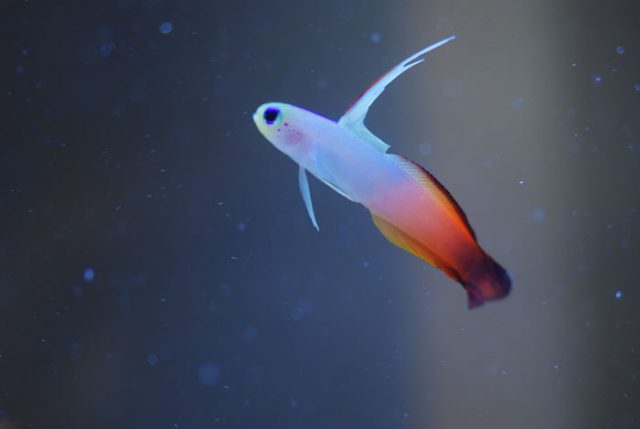
Firefish goby quick facts:
- Scientific Name: Nemateleotris magnifica
- Common Names: Firefish goby, fire goby, fire dartfish, magnificent dartfish
- Size: About 2-3 inches
- Minimum tank size: 29 gallons
- Aggression Level: Peaceful
- Care Level: Easy
- Most Active: Day
- Lifespan: About 3 years
- Endangered status: Least concern
Is a Firefish a hardy fish?
The Firefish goby is considered to be a hardy fish as long as two important care elements are accounted for:
- Do not add them to tanks with aggressive or semi-aggressive fish, because Firefish are shy and may become injured or starve
- Be sure to have a tight-fitting lid, because they may jump out of the tank
The natural habitat of Nemateleotris magnifica
Naturally found in reef environments located in both the Pacific and Indian oceans, Nemateleotris magnifica can be found swimming at depths from about 20 to 200+ feet in the reefs around Hawaii and some areas of Africa. The firefish often face against the current to let prey naturally come to them instead of hunting like many other species of fish.
The Nemateleotris magnifica is currently not endangered and prefers to live alone after reaching adulthood. Once the firefish goby has found a mate, they will live together in pairs. Most commonly this fish can be found in sand burrows, especially when a threat is near. To communicate in the wild, the firefish uses its dorsal fin to alert other of potential danger. I’ve never observed it in the wild, but it sure is fun to watch in your tank.
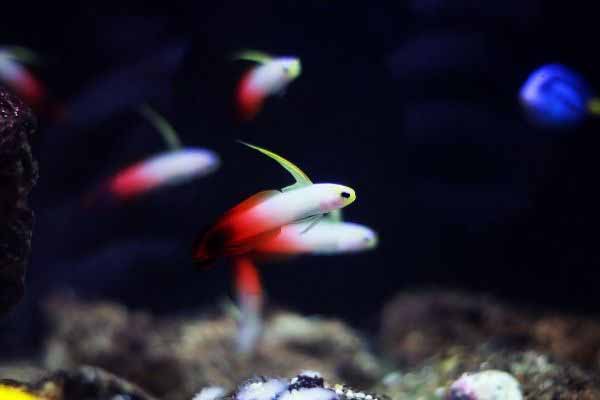
Proper aquarium care, conditions & behavior for the fire goby
Caring for the fire goby in your saltwater aquarium is going to be fairly straightforward, by traditional reef aquarium standards. Since this is a small saltwater aquarium fish, it doesn’t require a large tank. Anything in the 29+ gallon range should be sufficient.
Standard reef aquarium water parameters are appropriate
Be careful, Firefish like to jump
The fire goby is notorious for being a gorgeous, peaceful, and calm saltwater fish for a community tank when mixed with other species, but is highly aggressive most times when kept with others of the same or similar species.
A few people have reported that they seem to prefer moderate to slow-moving parts of the tank, rather than the areas of greatest current, so you might want to think twice about adding them to your tank if you have powerful currents (for example, with certain branching SPS corals as the dominant species).

The most important advice is to make sure you have a tight-fitting lid on your aquarium or netting around the edges because while the fire goby has a life expectancy of about 3 years, most are cut way short because they have a bad habit of jumping out of tanks. Jumping becomes even riskier when the species becomes stressed or feels threatened.
- To safely house the Nemateleotris magnifica, you must have a secure lid on your tank at all times.
- To keep stress low, you need to provide plenty of hiding spots for the firefish.
- In the wild, the firefish does enjoy sand burrows. Try using a sand substrate in your tank that is deep enough for this fish to burrow into.
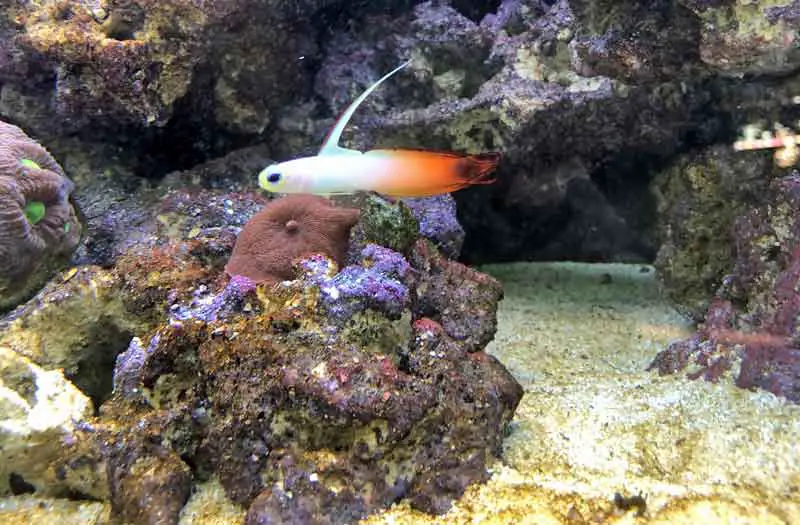
Depending on how you have designed and aquascaped or decorated your saltwater aquarium, a simple short section of PVC pipe is a great spot for the fire goby to hide.
Are Firefish reef safe?
Firefish are docile creatures that will leave your corals and invertebrates alone, which qualifies them as reef safe, with little to worry about.
Is the Firefish goby hardy?
Yes, the Firefish goby is hardy and adapts well to life in an aquarium. They will eat a variety of foods and add beautiful, peaceful colors.
Are Firefish poisonous?
Nemateleotris magnifica, commonly known as the Firefish gets its name from the gorgeous red, orange and yellow colors and is a peaceful, non-poisonous tropical reef fish. The trouble with common names, like “Firefish” is that more than one species may be called that. For example, the Red lion fish, like all lion fish, does have venom-tipped fins that would cause a painful sting.
Missing fish?
It is not uncommon for a newly introduced fire goby to spend a significant amount of time hiding in the rocks–so if your firefish has disappeared for a while–check the floors immediately–as long as they haven’t started surfing the carpet, you can breathe a little easier that they may just be hiding in the rockwork. If that’s the case, they’ll come back out when they feel secure.
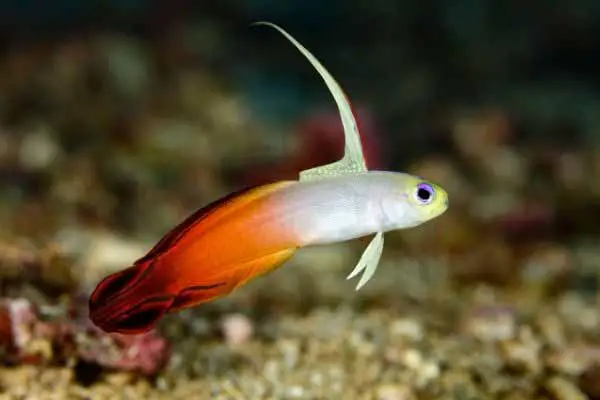
Firefish goby compatibility
The fire dartfish is a peaceful species of community fish that will generally mix well with other non-aggressive fish. Use caution when adding them late to an established reef tank, if your tank already has fish that are defining territories. This mild-mannered dartfish may become the victim of fish aggression and bullying if they are added too late in the pecking order.
So use caution when combining with yellow tangs or blue tangs, or other fish that can be semi-aggressive.
That is what happened to the last one that I added to my tank. I have a pair of clownfishes who have decided all 92 gallons are there (in a radius that extends out from their flower pot).
They were not big fans of the fire dartfish at all, and they let him or her know it every few minutes until separated.
However, this magnificent creature will co-exist nicely with other mild-mannered fish.
Use this great saltwater fish compatibility tool to find other saltwater fish that are compatible with Firefish, or any other fish group, for that matter.
Are Firefish aggressive?
No, Firefish are not aggressive. The name is given because of their brilliant red/orange/yellow and white coloration, not because of any firey temper. They are a mild-mannered, hardy, and easy-to-care-fore saltwater fish species.
How many firefish can be kept together in one tank?
Firefish will display aggression towards others of the same family, so it is definitely best to keep just one Firefish per tank unless you have purchased a bonded pair or have the means to establish the pair in your tank. But please exercise caution here as they are not very easily paired.
Personal observation on pairing
I don’t recommend placing more than a single dartfish in the tank unless you have a lot of time to monitor and separate the two if aggression arises. A few years back I was unsuccessful in trying to establish a pair. There was a lot of aggression/territoriality.
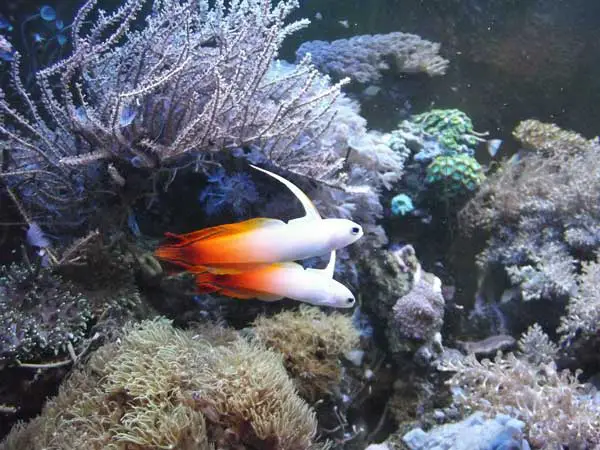
While it is possible to pair them up of the species in a tank. While these fish can form pairings in opposite sex-groups, they are generally territorial to each other. Territorial actions get even worse when placed in a minimum sized tank where the fish can’t freely swim without bumping into one another. Juvenile firefish will often be seen swimming in groups, but once adulthood is reached, chances are high, these fish will begin to quarl.
Commonly placed in reef communities with the firefish goby are clownfish, shrimp, and other small goby. This fish can be a great asset if you have other shy fish breeds in your tank. Firefish are labeled as “dithers,” meaning that they help other fish come out of their shells. This breed of fish won’t eat on plants or disturb invertebrates in your tank.
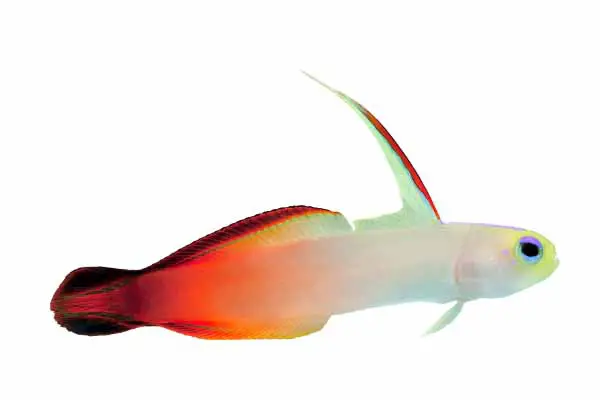
Recommended tankmates to keep with a Firefish goby
As mentioned earlier, this is a peaceful, mild-mannered fish, so it is generally best to keep with other similarly non-aggressive fish, like Amphiprion clownfish or pink skunk clownfish, engineer gobies, neon gobies, Banggai cardinalfish, Mandarin fish, or even a Royal gramma, etc.
This is a great fish to keep with a mild-mannered ocellaris clownfish.
Breeding Nemateleotris magnifica in captivity
Sadly, the firefish goby is a hard fish to sex. There are no telling signs of whether a firefish goby is either male or female. If two firefish do make a pairing, it’s safe to assume they are of the opposite sex. Breeding is a bit of a mystery with species as well. Due to their shy nature, it’s been hard to observe the firefish’s breeding patterns.
Firefish goby care and feeding
The firefish goby is a planktivore, meaning it naturally adapted to eat floating, prey suspended in the water column. So they do well when fed meaty foods like live black worms, mysid shrimp, brine shrimp, or other seafood preparations (Michael 2001).
Where To Buy
The marine firefish goby can be found in many pet shops around the world. This includes many online pet shops. A single firefish goby usually costs no more than $10-15.
Conclusion: Who should and should not add a firefish goby to their saltwater aquarium?
Who should consider adding a firefish goby to their saltwater tank?
- Anyone who wants a gorgeous, slender, and shy fish–as long as you don’t have any semi-aggressive or aggressive bullies in the tank.
Who should not add a firefish goby to their tank?
- Anyone with aggressive or territorial fish
- Even those with mild-mannered community fish but with tanks that lack a proper way of preventing the fish from jumping (like a lid or mesh netting)
- If you already have a dartfish in your tank
- If your tank is less than 3 months old
Want to learn more about other similar saltwater fish?
If you want to learn more about similar saltwater fish species, check out a few of these other amazing saltwater fish:
- The firefish goby’s close cousin is the Purple firefish goby (Helfrichi)
- Digging the engineer goby
- Other shy saltwater fish
- Mandarin goby
Looking for something totally different, instead?
If you’ve seen enough and want to learn about a different type of saltwater fish, check out a few of these options:
References
Michael, Scott. Marine Fishes: 500+ Essential-to-know aquarium species. TFH Publications 2001.



Leave a Reply